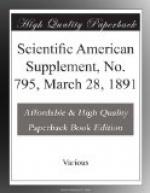The first wheel (72 inch) made after the patent was granted was sold to Brightwell & Davis, Farmville, Va., and put into their flour mill under six feet head. In 1870, Brightwell & Davis sold their mill to Scott & Davis. Afterward G.W. Davis owned and operated the mill and put in one 1858 patent “New Turbine.” In 1889 the Farmville Mill Company bought and remodeled the mill to roller process and required more power than the old 1856 Jonval turbine and 1868 “New Turbine” would yield, and on Aug. 30, 1889, sold the Farmville Mill Company two 54 inch new improved Standard turbines to displace the two old wheels. In 1860 he commenced experimenting with different forms of buckets and chutes, and used six chutes instead of four as first made, and was granted patent March 24, 1863.
This addition of chutes proved beneficial, as the wheel worked better with the gates partly opened than it did with four chutes. His next invention was granted him Dec. 24, 1867, which he called Burnham’s improved central and vertical discharge turbine.
This improvement consisted in making the guide blade straight on the outside (instead of rounding, as then made by all others), from inner point back to bolt or gudgeon, and thick enough at the latter point to let water pass without being obstructed by said bolt and the arrangement for shifting the water guides. Two 42-inch wheels of this pattern were built and put into operation, but they soon commenced leaking water and became troublesome on account of the many small pieces of castings and bolts, and were abandoned as worthless. There are several manufacturers of this style of wheel that advertise them as “simple and durable.” Such a complicated case with twelve chutes cannot be made to operate unless by a large number of castings, bolts and studs. With these adjustable water guides, one of the objects was obtained. Admitting the water to the wheel through chutes corresponding in height to the outer edge of buckets exposed, but not placing the water against the face of the buckets at right angles with the center of the wheel, except when the guide blades were full opened, for as the guides are changed so is the current of the water likewise changed.
After making several differently constructed wheels and testing them a number of times, he selected the best one and obtained a patent for it March 3, 1868, and called it “new turbine,” which he still further improved and patented May 9, 1871. This “new turbine” consisted of the former improved Jonval wheel, hub and buckets, with a new circular case and new form of chutes, having a register gate entirely surrounding the case and having apertures corresponding to those in the case for admitting water to the wheel. This register gate was moved by means of a segment and pinion.




